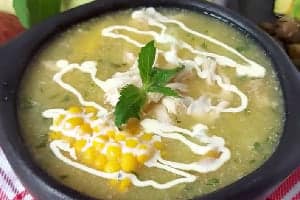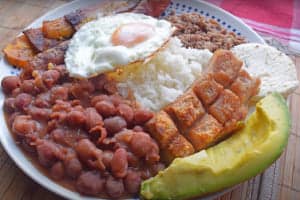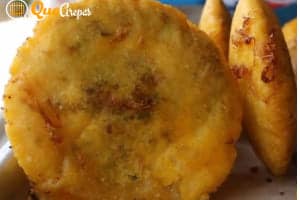The best Arepas recipes
South American food is an indigenous food that has been influenced by the old world. In Venezuela and Colombia, arepas are a staple food: made with corn flour, it is an ancient dish that has been made for generations. The hierarchy of rich and poor has sparked the creativity of the culinarians of these regions, transforming the arepa from a humble stuffing bread as a side dish to a full, rounded dish.
- Types of Arepas
- Venezuelan Arepas
- Colombian Arepas
- Let's talk about arepas
- Benefits of Corn Arepa
- How are arepas classified?
-
Frequently Asked Questions
- Where are the arepas from?
- Differences between Venezuelan and Colombian Arepas
- What are arepas made of?
- What to eat arepas with?
- How many calories does an arepa have?
- How are arepas made?
- How many arepas can be made with one kilo of PAN flour?
- How to make arepas that are not hard?
- Tricks to obtain a better dough for arepas
- Is the arepa the best breakfast in the world?
- A little History about corn and arepas
- History of the Arepa in Venezuela and the world
Types of Arepas
What are the types of arepas?
Given the great variety of arepas that exist and that are created all the time, it is difficult to make a classification. In order to organize the information presented in this website, we have classified the types of arepas in three main ones:
Venezuelan Arepas
Colombian Arepas
Colombian Food to Enjoy
Latest posts
Let's talk about arepas
Let's talk about arepas and help each other discover a delicious answer.
But what are arepas, you ask?
What is an arepa?
The arepa is a flatbread made from ground corn dough or pre-cooked corn flour and plays an important role in the cuisine of northern South America. It is a round cornbread that comes in various sizes and thicknesses, from extremely thin discs to small, fat patties.
What does arepa mean?
The word arepa is pre-Columbian and probably derives from the word erepa, which means corn in the Cumanagua language.
It is the language of the Cumanagoto, the indigenous people of Venezuela, whose descendants currently live in the eastern part of the country.
Traditionally, arepas are baked on a plancha. The plancha is a round iron or clay plate that is heated directly over a fire or embers.
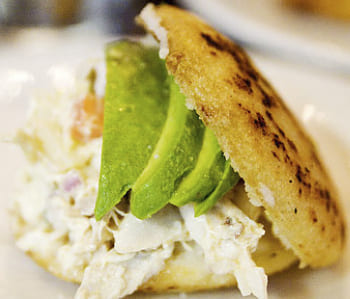
Where is the arepa from? Is the arepa Venezuelan or Colombian?
What country is the arepa from?
Arepas are a traditional dish in Venezuelan and Colombian homes. There is much discord about the country of origin of the arepa. The most important thing is the brotherhood of the two countries, which in addition to arepas, share many values and history that unite us. These two countries have different ideas about how to serve arepas. One of them focuses more on the filling, while the other one focuses on the bread.
How is the arepa eaten in Venezuela?
It is eaten every day and can accompany a main dish or be eaten stuffed with a wide variety of options, such as cheese, avocado and chicken, carne esmechada, ham and cheese, diablito, among others. Always with a touch of butter when opening before stuffing, it is the most typical way of eating in Venezuela.
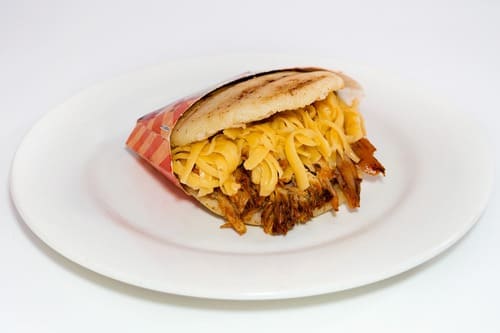
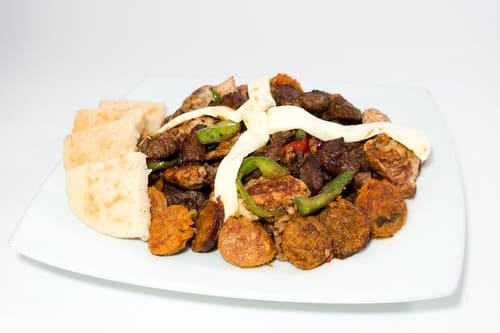
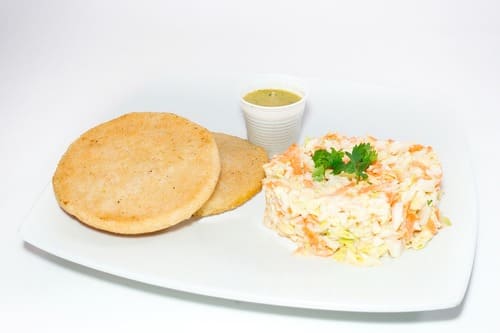
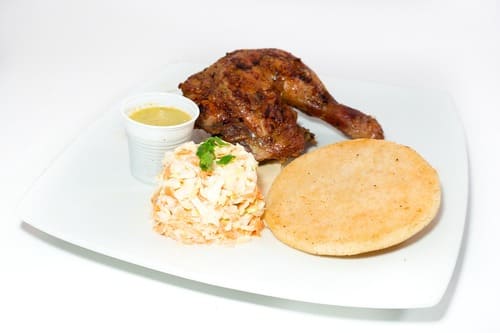
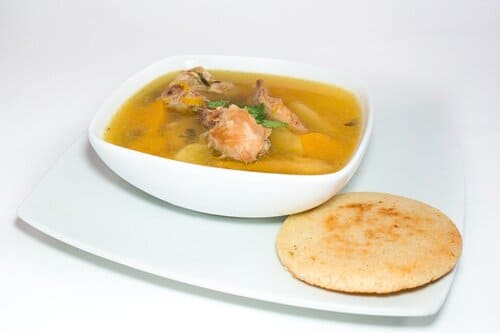
Benefits of Corn Arepa
Corn flour is a product that provides nutrients to our diet. It has protein, as well as iron and vitamin A. Arepa is a delicious and healthy food, rich in fiber, proteins and carbohydrates, which makes it an ideal food for adults and children.
Arepa is an excellent food that provides the necessary nutrients -protein, fiber and energy- in the diet. It also contains vitamins A, B and E; Magnesium and antioxidants.
One of the main advantages of the arepa is that it has a glycemic index around 60, which is much lower than bread. This makes it the food of choice for people with diabetes and insulin resistance. If this sounds good to you, it gets better. With the addition of wheat bran or bran bran bran, the index drops to 40-45, which makes it vegetarian. You can add about 3 or 4 tablespoons of bran to the amount of dough as indicated in this recipe. It does not affect the taste and makes it healthier.
Some people also grate zucchini, carrots or eggplant into the batter, similar to the bran. They are also delicious with toasted sesame seeds.
How are arepas classified?
According to the way of cooking
In addition to their basic classification according to the origin of the arepa, i.e. Venezuelan arepas and Colombian arepas, there are other differences. The way they are cooked is one of them and they are mainly divided into the following categories:
- Arepas asadas: are the most traditional. They are cooked on a budare (a frying pan also works) over medium heat. In some cases they are passed through the budare for a short time, until a small shell is formed or they are sufficiently cooked, and then placed in the oven to finish cooking. This form of cooking also includes the traditional wood stove, where the grandmothers originally cooked and where it is still done in many homes.
- Arepas fritas: For those who love oil, this is another way to cook arepas. In Venezuela they are very famous for the little hole that is made in the center before frying.
- Arepas con máquinas (tostyarepas): technology has reached this food delicacy and there are electric devices that allow you to place a wheel of dough and in about 7 minutes they are ready. They work like a sandwich maker and for the busy life of these days can be quite comfortable. The final result is not the same, but between tastes and colors it is acceptable to some.
According to the way of preparation
The versatility of the arepa is superior to many foods and it is eaten in different ways, among which we have:
Maíz acaparado: is nothing more than regular corn that has had the light and husk removed. It can be used to produce yellow, coarser, but hand-processed corn meal and white, softer, common corn meal.
Maíz descascarillado: This corn retains its husk and is softened by boiling it with lime. When milled, the nutrients from the lime and the husk are preserved. It is used to make "Arepas Peladas" in western Venezuela and "Arepas Raspadas" in eastern Venezuela.
- Maíz pilado: It is the normal corn that is subjected to a process in which the lumen and husk are previously removed. With the corn pilado you can prepare arepas of yellow corn, which is rougher but artisanal, and arepas of white corn, which is soft and more common.
- Maíz pelado: Es aquel que conserva su cáscara y que se ablanda hirviéndolo con cal. al molerlo, conserva los componentes nutritivos del lumen y la cáscara. Con este se realizan "Arepas Peladas" tal como son conocidas en el occidente venezolano y "Arepas Raspadas" en el oriente del país.
- Arepa de harina de maíz sola: is enjoyed as an accompaniment to a main dish, substituting what in other regions is bread.
- Arepa de harina de maíz incorporando otros ingredientes: is an arepa prepared with corn flour in the traditional way, but with the addition of another ingredient in the same preparation. This ingredient is added during the kneading process. A simple example of this type of arepa is one in which grated cheese is added during the kneading process. The "chicharón" arepa is another example of this type of arepa, others would be with bran, yucca and stop counting what can be done.
- Arepa sin harina de maíz elaborada con otros ingredientes: are arepas in which corn flour is not used. Their shape and preparation is the same, but the main ingredient can be very varied: yucca, carrots, beets, plantains.
- Arepa de harina de maíz rellena: The most common way to eat them in Venezuela is stuffed with any number of ingredients and flavor combinations. An infinity of types have been created with very nice names that try to describe the filling: pelúa, sifrina, reaina pepiada, de queso, jamón y queso, rompe colchón, pabellón, domino.
Frequently Asked Questions
Where are the arepas from?
Where arepas originate from is one of the most frequent questions our readers ask us. It is a permanent discussion whether it is from Venezuela or Colombia, the important thing is that its flavor, in the different presentations that exist, conquer every day more palates around the world.
Differences between Venezuelan and Colombian Arepas
The difference between Venezuelan and Colombian arepa recipes is not that one is better than the other, in fact, both are very delicious, as they are completely different from each other. Venezuelan recipes are more about what goes into the arepa, while Colombian recipes are more about how the arepa is made and the type of dough, which varies in size, color and thickness.
What are arepas made of?
The world famous classic arepas are basically made with corn flour, water and a touch of salt. Nowadays, it has become popular to make arepas with an infinite number of ingredients, in some cases mixed with corn flour and in others without corn flour, which is substituted by another ingredient.
What to eat arepas with?
Arepas are eaten alone, with butter and of course filled with whatever you like. This last way of eating them was born in Venezuela, since in Colombia they are eaten more as an accompaniment to a main meal. Stuffed arepas have become popular all over the world and in Venezuela they are given very peculiar names: pelúa, sifrina, dominó, reina pepiada, among many others.
How many calories does an arepa have?
A corn flour arepa of an average size of 50 grams has approximately 180 calories. Spreading it with butter and filling it with some ingredient, increases this value.
How are arepas made?
The basic way to make the arepa is to mix corn flour with water and salt. But in each country they are made in a different way, you can see that in each of the sections of our website. In Venezuela, Colombia, Costa Rica, Spain, among other countries have peculiar ways of making their arepas.
How many arepas can be made with one kilo of PAN flour?
With one kilo of PAN flour or another brand with the same consistency, approximately 20 arepas can be made.
How to make arepas that are not hard?
The arepas are hard mainly for two reasons:
- Corn flour is of poor quality: there are brands of flour that are not the best and the result is a hard dough. To solve this situation a little, it may help if the water in the dough is lukewarm to warm and knead well.
- Lack of water in the mass: when the amount of water is in accordance with the amount of flour, it is very easy for the dough to be soft. We recommend one cup of water for one cup of flour.
Tricks to obtain a better dough for arepas
There are small details that can make the difference between an ideal dough and one that is not.
- First the water, then the flour: it is definitely better to put the water in first. This allows the flour to be added little by little and stirring, so that no lumps will form in the dough.
- Let the dough rest: If we use the right amounts of water and flour, we put the water first and then the flour slowly and stirring, before starting to knead it is advisable to let the dough rest for a few minutes. This allows the flour to completely absorb the water. When we start to knead we will realize if more water or more flour is needed.
- Use lukewarm water: warm water allows better mixing with the flour and helps to obtain a softer dough.
Is the arepa the best breakfast in the world?
At least for the number of Venezuelans, Colombians and other nationalities that have adopted the arepa, the answer is a resounding yes. Many nutritionists say so because of the amount of nutrients included in them. If corn flours were not so processed or if corn were used directly to make arepas, they would be perfect.
A little History about corn and arepas
The ancestors of the arepa were a staple food of the Timotocuicas, a group of Indians living in the northern Andes of Venezuela. Other Indian tribes in the region, such as the Arawaks and Caribs, widely consumed a type of yucca made from the silk plant. With Spanish colonization, the dish that would become arepa spread throughout the region, then known as the Viceroyalty of New Granada and later, with independence, as Gran Colombia (Colombia, Venezuela, Ecuador, Panama).
It was Christopher Columbus who introduced Europeans to the first golden kernels of corn. In his hurried search for the Indies he found a continent from which he brought neither silks nor spices, but a grain that, together with rice and wheat, is the basis of the triad of world food consumption today.
Completely unknown in the Old World, maize (scientific name zea mays) had been established in the Americas for centuries. There is evidence that a type of wild corn was growing in Mexico as early as 80,000 B.C. No one knows how it evolved into today's corn, but evidence shows that Mexican Indians were growing and consuming it at least as early as 4,000 B.C.
When the Spanish arrived in the New World, corn was already established as a crop throughout the Americas. Today, in North America, corn is consumed mainly as a cereal in the form of cornflakes, popcorn, muffins and polenta. By-products, such as corn oil and syrups, are widely used.
The list of uses of corn in Latin America is enormously rich, as corn is the basis of much of the regional cuisine. It is used to make bread, tortillas, tamales, empanadas, fritters and arepas, as well as to prepare beverages such as atole, champurriada, guarapo, mazato, champus and chicha.
It is also used in soups, ajiaco, stews, masamorra and polenta. It is consumed on the cob, roasted and baked. Arepas are found in all regions of Colombia and Venezuela.
History of the Arepa in Venezuela and the world
We hope you liked this article about The best Arepas recipes%.

